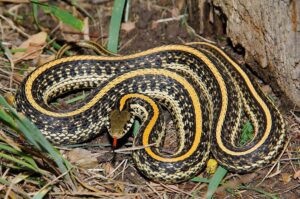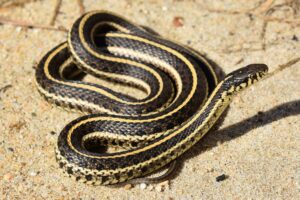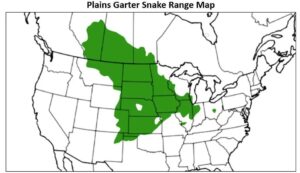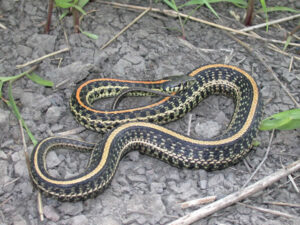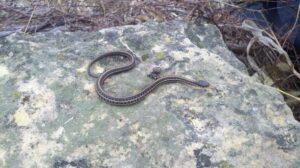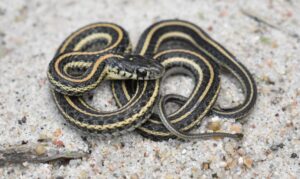The slender, attractive, and medium-sized plains garter snake is endemic to most of the central United States as far south as Texas and as far north as Canada. The colubrid is most active between April and late October, but the activity period can vary with location. It prefers to live a solitary life but hibernates in small groups. It is diurnal but can become nocturnal during summer to avoid the heat.
Scientific Classifications
- Suborder:Serpentes
- Family:Colubridae
- Genus:Thamnophis
- Species:T. radix
Conservation Status
Description
Size
They are around 3 ft (0.91 m) in length.
Color and Appearance
The gray-green colored body has a distinctive yellow or orange stripe extending from its head to its tail. The lip has distinctive black bars. The lateral stripes on the third and fourth scale rows are usually of a greenish-yellow shade. There are small dark spots along the edges of the belly. Most of them have distinctive light yellow spots on the top of their heads.
Are They Dangerous to Humans
When someone attacks or tries to pick it up, the plains garter snake defends itself by attempting to bite and release a foul-smelling musk. It is mildly venomous, but its venom is not toxic to humans.
Plains Garter Snakes at a Glance
Distribution
Its range spans a wide area of North America, from central Alberta in the north to New Mexico and Northern Texas in the south. In the US, it is also found in Illinois, Iowa, northern Kentucky, eastern Wyoming, eastern Colorado, southern Wisconsin, Minnesota, northwestern Indiana, Nebraska, Oklahoma, Ohio, and the northern half of Missouri. Canada also has it in Manitoba.
It lives at elevations from 400ft-7500ft but prefers to stay at 6000ft.
Habitat
It frequents prairies and meadows adjacent to water sources, such as streams, marshes, and ponds. It can be found in trash heaps, vacant lots, and abandoned buildings in heavily built-up areas. But its population in urban and suburban areas has been dramatically reduced due to construction activities and unregulated pesticide use.
Described as one of the most cold-tolerant snakes, the plains garter snake often comes out of hibernation on warmer winter days to bask in the sun.
Lifespan
The snake lives for around 8.5 years.
Predators
It is consumed by birds of prey like Swainson’s hawks, red-shouldered hawks, northern harriers, and kestrels. Other predators include foxes, striped skunks, coyotes, domestic cats, minks, and milk snakes.
Diet
Slugs, earthworms, and small amphibians, including salamander larvae, typically form its diet. It also eats small mammals and birds like eastern meadowlarks and bank swallows.
Reproduction
Viviparous (gives birth to live young)
Courtship usually takes place near the communal hibernation site, and the species follows a polygynous mating system. Mating normally occurs in April or May, with the young being born from August to October. 5-60 babies, measuring 6-7.5 inches each, form a litter.
Source
education.mdc.mo.gov, sdherps.org, birdwatchinghq.com, srelherp.uga.edu, iowaherps.com

